oil additives MERCEDES-BENZ GLC SUV 2015 Owners Manual
[x] Cancel search | Manufacturer: MERCEDES-BENZ, Model Year: 2015, Model line: GLC SUV, Model: MERCEDES-BENZ GLC SUV 2015Pages: 497, PDF Size: 15.27 MB
Page 7 of 497
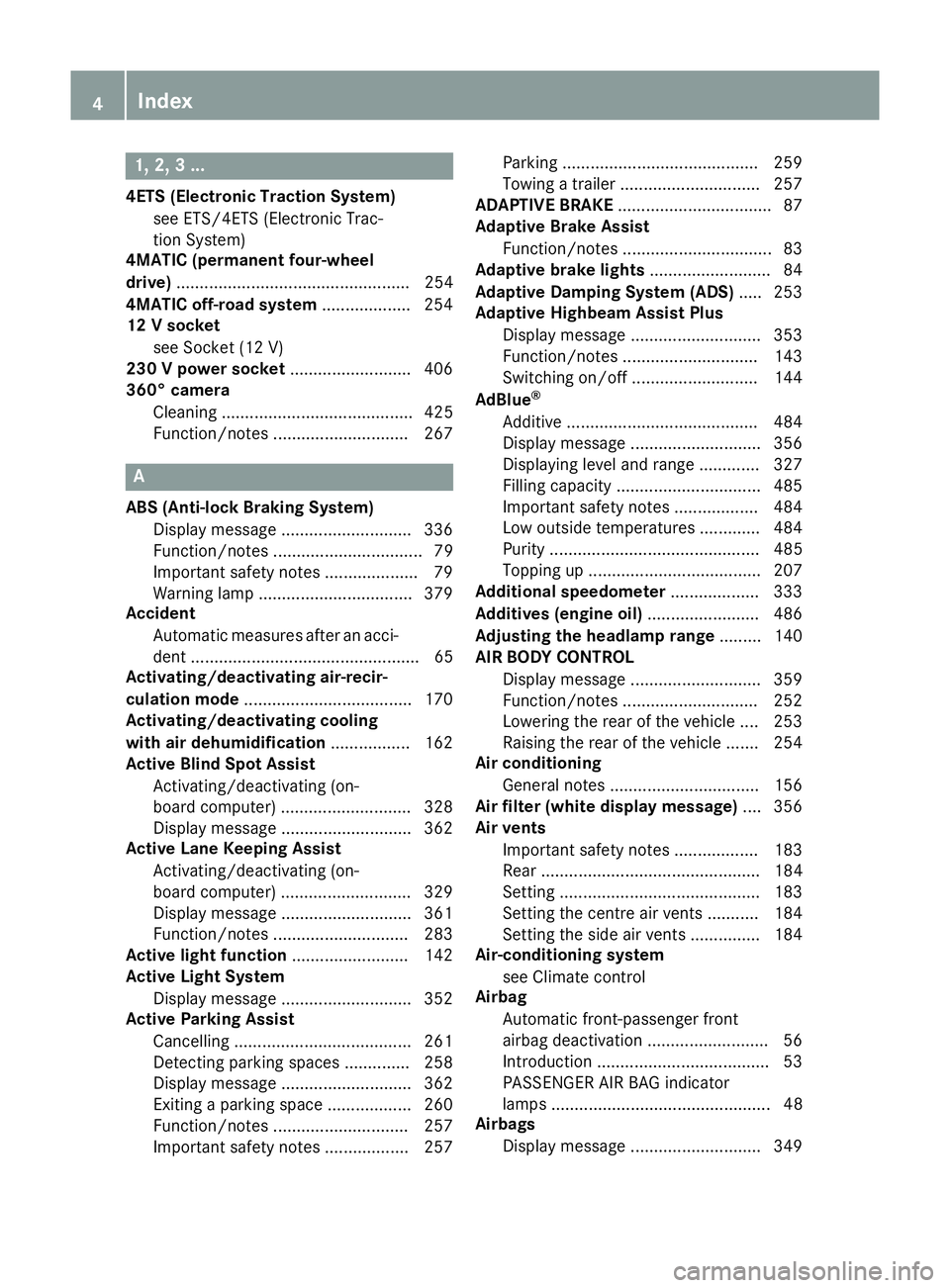
1, 2, 3 ...
4ETS (Electronic Traction System) see ETS/4ETS (Electronic Trac-
tion System)
4MATIC (permanent four-wheel
drive) .................................................. 254
4MATIC off-road system ...................254
12 V socket
see Socket (12 V)
230 V power socket .......................... 406
360° camera
Cleaning ......................................... 425
Function/notes ............................ .267 A
ABS (Anti-lock Braking System) Display message ............................ 336
Function/notes ................................ 79
Important safety notes .................... 79
Warning lamp ................................. 379
Accident
Automatic measures after an acci-
dent ................................................. 65
Activating/deactivating air-recir-
culation mode ................................... .170
Activating/deactivating cooling
with air dehumidification ................. 162
Active Blind Spot Assist
Activating/deactivating (on-
board computer) ............................ 328
Display message ............................ 362
Active Lane Keeping Assist
Activating/deactivating (on-
board computer) ............................ 329
Display message ............................ 361
Function/notes ............................ .283
Active light function ......................... 142
Active Light System
Display message ............................ 352
Active Parking Assist
Cancelling ...................................... 261
Detecting parking spaces .............. 258
Display message ............................ 362
Exiting a parking space .................. 260
Function/notes ............................ .257
Important safety notes .................. 257 Parking .......................................... 259
Towing a trailer .............................. 257
ADAPTIVE BRAKE ................................. 87
Adaptive Brake Assist
Function/notes ................................ 83
Adaptive brake lights .......................... 84
Adaptive Damping System (ADS) ..... 253
Adaptive Highbeam Assist Plus
Display message ............................ 353
Function/notes ............................ .143
Switching on/off ........................... 144
AdBlue ®
Additive ......................................... 484
Display message ............................ 356
Displaying level and range ............. 327
Filling capacity ............................... 485
Important safety notes .................. 484
Low outside temperatures ............. 484
Purity ............................................. 485
Topping up ..................................... 207
Additional speedometer ................... 333
Additives (engine oil) ........................ 486
Adjusting the headlamp range ......... 140
AIR BODY CONTROL
Display message ............................ 359
Function/notes ............................ .252
Lowering the rear of the vehicle .... 253
Raising the rear of the vehicle ....... 254
Air conditioning
General notes ................................ 156
Air filter (white display message) .... 356
Air vents
Important safety notes .................. 183
Rear ............................................... 184
Setting .......................................... .183
Setting the centre air vents ........... 184
Setting the side air vents .............. .184
Air-conditioning system
see Climate control
Airbag
Automatic front-passenger front
airbag deactivatio n .......................... 56
Introduction ..................................... 53
PASSENGER AIR BAG indicator
lamps ............................................... 48
Airbags
Display message ............................ 349 4
Index
Page 14 of 497
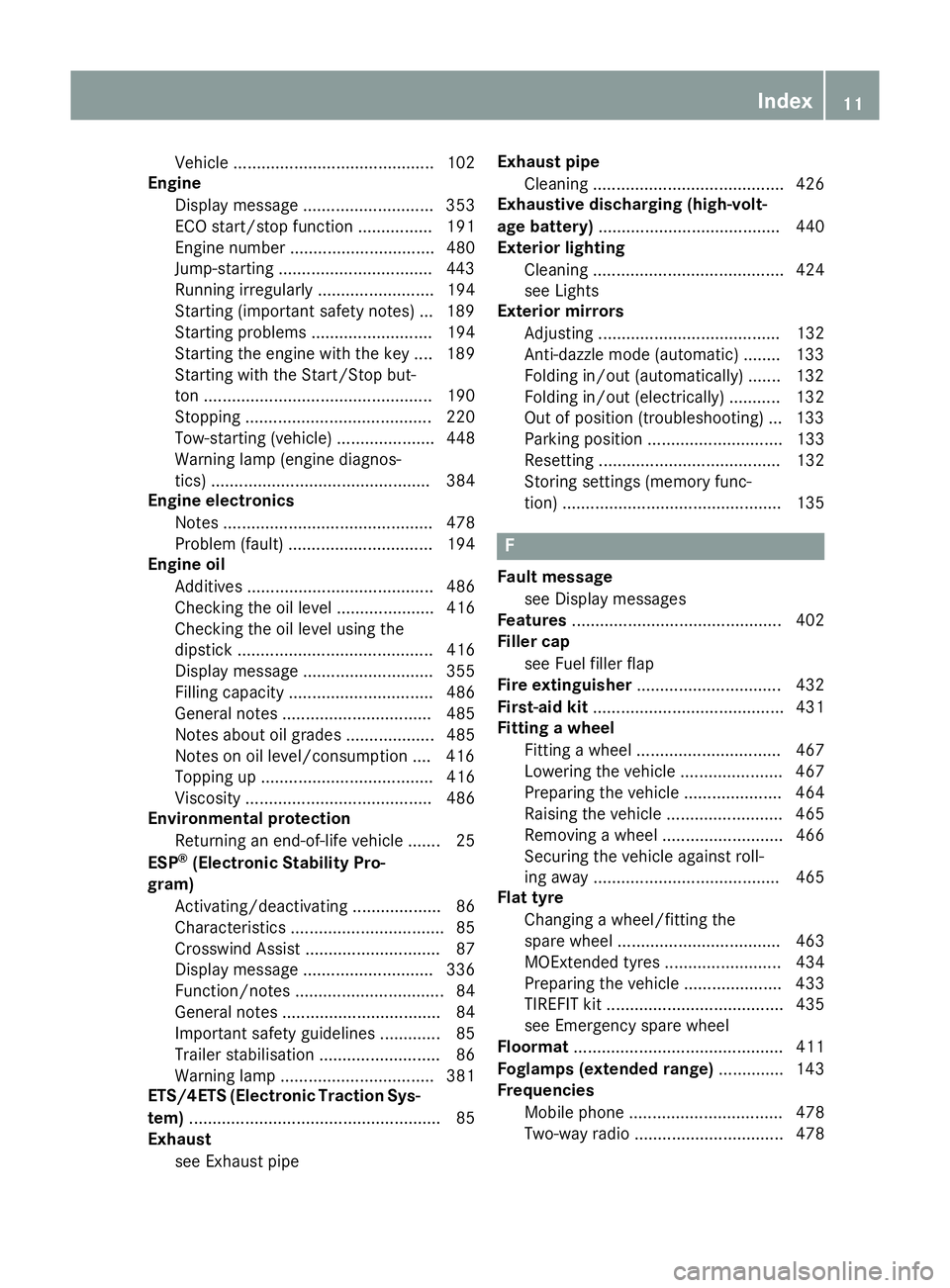
Vehicle ........................................... 102
Engine
Display message ............................ 353
ECO start/stop function ................ 191
Engine number ............................... 480
Jump-starting .................................4 43
Running irregularl y......................... 194
Starting (important safety notes )... 189
Starting problems .......................... 194
Starting the engine with the key .... 189
Starting with the Start/Stop but-
ton ................................................. 190
Stopping ........................................ 220
Tow-starting (vehicle) ..................... 448
Warning lamp (engine diagnos-
tics) ............................................... 384
Engine electronics
Notes ............................................. 478
Problem (fault) ............................... 194
Engine oil
Additives ........................................ 486
Checking the oil level ..................... 416
Checking the oil level using the
dipstick .......................................... 416
Display message ............................ 355
Filling capacity ............................... 486
General notes ................................ 485
Notes about oil grade s................... 485
Notes on oil level/consumption .... 416
Topping up ..................................... 416
Viscosity ........................................ 486
Environmental protection
Returning an end-of-life vehicle ....... 25
ESP ®
(Electronic Stability Pro-
gram)
Activating/deactivating ................... 86
Characteristics ................................. 85
Crosswind Assist ............................. 87
Display message ............................ 336
Function/note s................................ 84
General notes .................................. 84
Important safety guidelines ............. 85
Trailer stabilisation .......................... 86
Warning lamp ................................. 381
ETS/4ETS (Electronic Traction Sys-
tem) ...................................................... 85
Exhaust
see Exhaust pipe Exhaust pipe
Cleaning ......................................... 426
Exhaustive discharging (high-volt-
age battery) ....................................... 440
Exterior lighting
Cleaning ......................................... 424
see Lights
Exterior mirrors
Adjusting ....................................... 132
Anti-dazzle mode (automatic) ........ 133
Folding in/out (automatically )....... 132
Folding in/out (electrically) ........... 132
Out of position (troubleshooting) ... 133
Parking position ............................. 133
Resetting ....................................... 132
Storing settings (memory func-
tion) ............................................... 135 F
Fault message see Display messages
Features ............................................. 402
Filler cap
see Fuel filler flap
Fire extinguisher ............................... 432
First-aid kit ......................................... 431
Fitting a wheel
Fitting a wheel ............................... 467
Lowering the vehicle ...................... 467
Preparing the vehicle ..................... 464
Raising the vehicle ......................... 465
Removing a whee l.......................... 466
Securing the vehicle against roll-
ing away ........................................ 465
Flat tyre
Changing a wheel/fitting the
spare whee l................................... 463
MOExtended tyre s......................... 434
Preparing the vehicle ..................... 433
TIREFIT kit ...................................... 435
see Emergency spare wheel
Floormat ............................................. 411
Foglamps (extended range) .............. 143
Frequencies
Mobile phone ................................. 478
Two-way radio ................................ 478 Index
11
Page 23 of 497
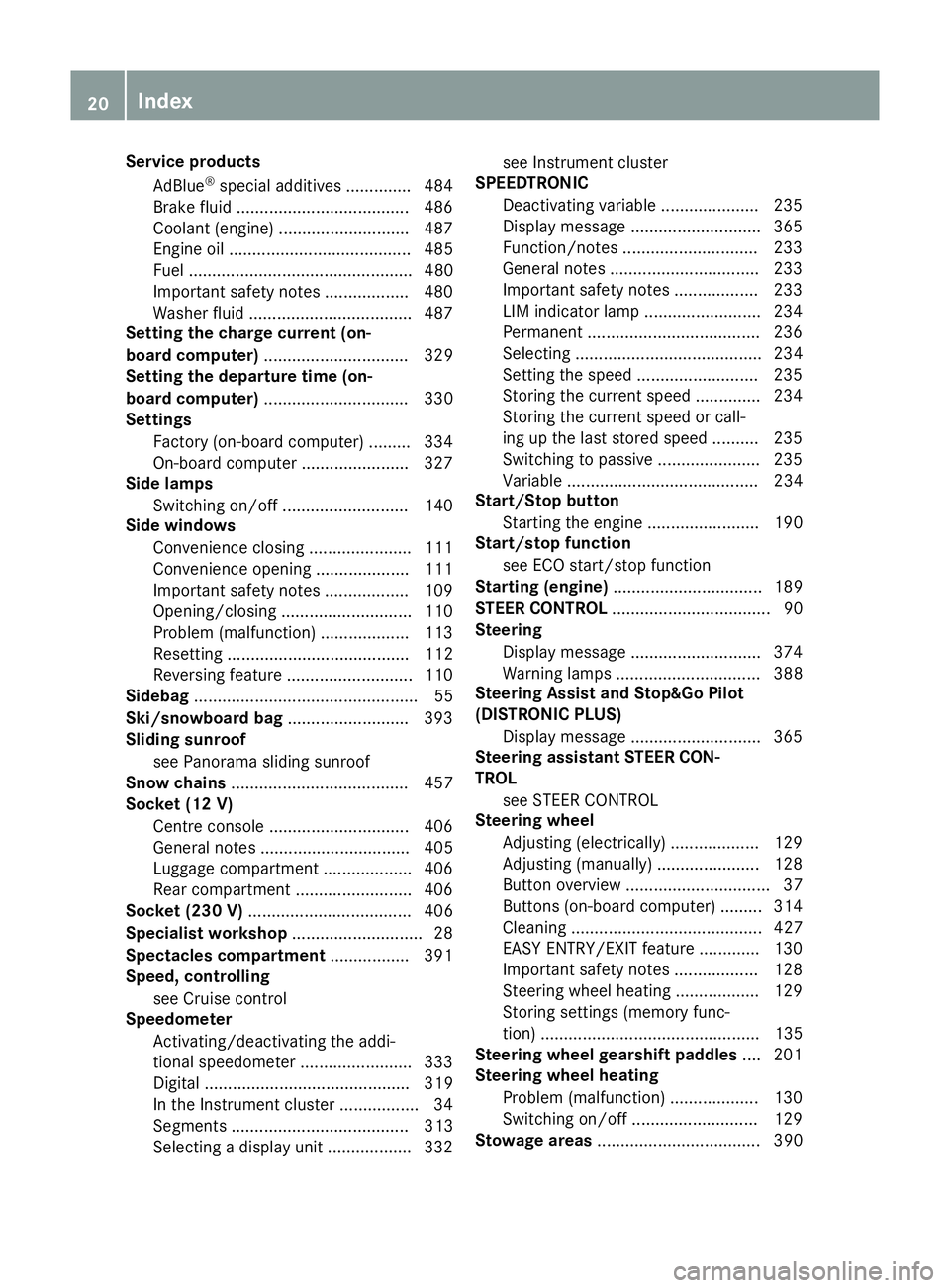
Service products
AdBlue ®
special additives .............. 484
Brake fluid .....................................4 86
Coolant (engine) ............................ 487
Engine oil ....................................... 485
Fuel ................................................ 480
Important safety notes .................. 480
Washer fluid ................................... 487
Setting the charge current (on-
board computer) ............................... 329
Setting the departure time (on-
board computer) ............................... 330
Settings
Factory (on-board computer) ......... 334
On-board computer ....................... 327
Side lamps
Switching on/off ........................... 140
Side windows
Convenience closing ..................... .111
Convenience opening .................... 111
Important safety notes .................. 109
Opening/closing ............................ 110
Problem (malfunction) ................... 113
Resetting ....................................... 112
Reversing feature ........................... 110
Sidebag ................................................ 55
Ski/snowboard bag .......................... 393
Sliding sunroof
see Panorama sliding sunroof
Snow chains ...................................... 457
Socket (12 V)
Centre console .............................. 406
General notes ................................ 405
Luggage compartment ................... 406
Rear compartment ......................... 406
Socket (230 V) ................................... 406
Specialist workshop ............................ 28
Spectacles compartment ................. 391
Speed, controlling
see Cruise control
Speedometer
Activating/deactivating the addi-
tional speedometer ........................ 333
Digital ............................................ 319
In the Instrument cluster ................. 34
Segments ...................................... 313
Selecting a display unit .................. 332 see Instrument cluster
SPEEDTRONIC
Deactivating variable ..................... 235
Display message ............................ 365
Function/notes ............................ .233
General notes ................................ 233
Important safety notes .................. 233
LIM indicator lamp ......................... 234
Permanent ..................................... 236
Selecting ........................................ 234
Setting the speed .......................... 235
Storing the current spee d.............. 234
Storing the current speed or call-
ing up the last stored speed .......... 235
Switching to passive ...................... 235
Variabl e......................................... 234
Start/Stop button
Starting the engine ........................ 190
Start/stop function
see ECO start/stop function
Starting (engine) ................................ 189
STEER CONTROL .................................. 90
Steering
Display message ............................ 374
Warning lamps ............................... 388
Steering Assist and Stop&Go Pilot
(DISTRONIC PLUS)
Display message ............................ 365
Steering assistant STEER CON-
TROL
see STEER CONTROL
Steering wheel
Adjusting (electrically) ................... 129
Adjusting (manually) ...................... 128
Button overview ............................... 37
Buttons (on-board computer) ......... 314
Cleaning ......................................... 427
EASY ENTRY/EXIT feature ............. 130
Important safety notes .................. 128
Steering wheel heating .................. 129
Storing settings (memory func-
tion) ............................................... 135
Steering wheel gearshift paddles .... 201
Steering wheel heating
Problem (malfunction) ................... 130
Switching on/of f........................... 129
Stowage areas ................................... 39020
Index
Page 420 of 497
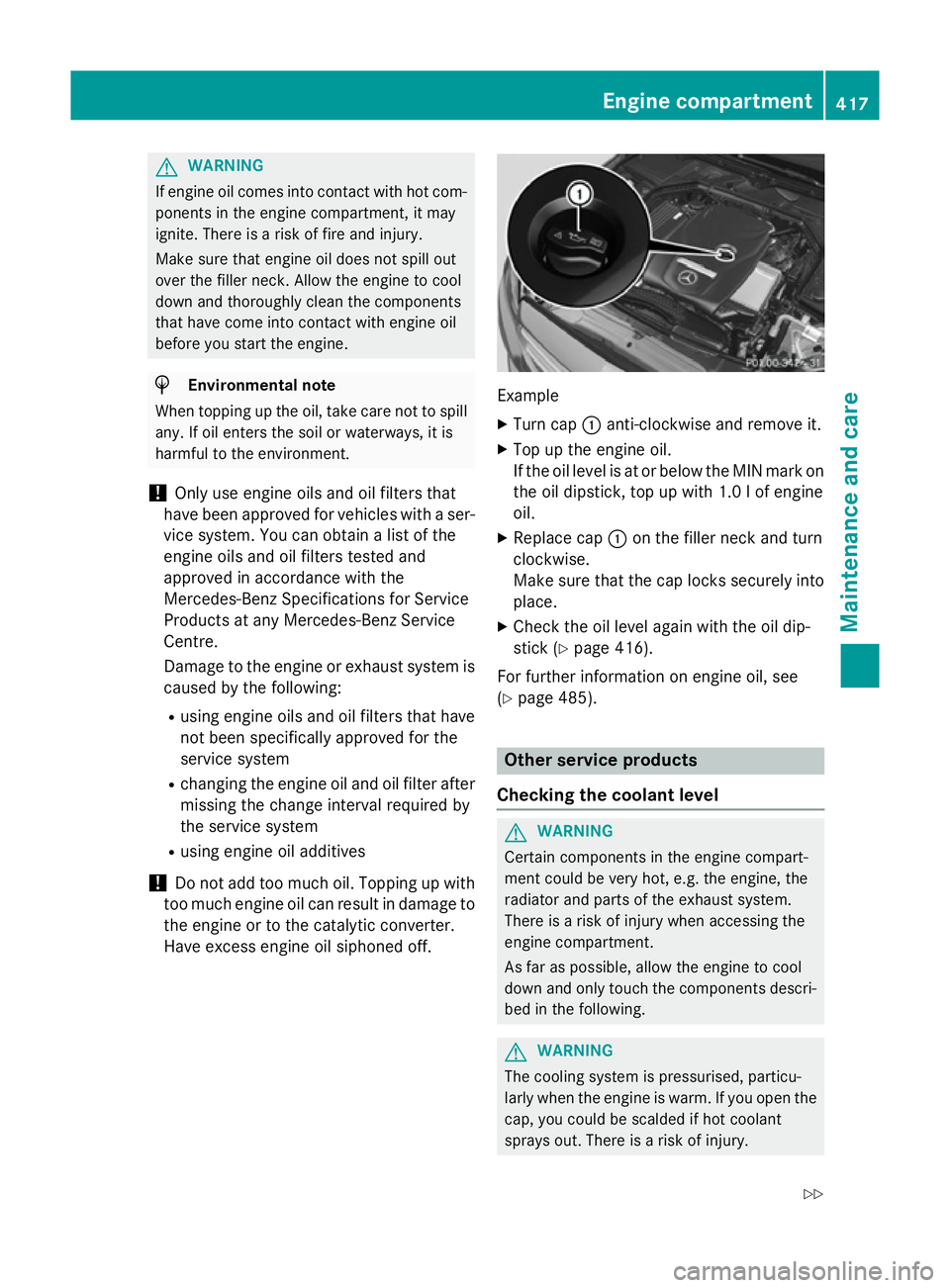
G
WARNING
If engine oil comes into contact with hot com- ponents in the engine compartment, it may
ignite. There is a risk of fire and injury.
Make sure that engine oil does not spill out
over the filler neck. Allow the engine to cool
down and thoroughly clean the components
that have come into contact with engine oil
before you start the engine. H
Environmental note
When topping up the oil, take care not to spill
any. If oil enters the soil or waterways, it is
harmful to the environment.
! Only use engine oils and oil filters that
have been approved for vehicles with a ser-
vice system. You can obtain a list of the
engine oils and oil filters tested and
approved in accordance with the
Mercedes-Benz Specifications for Service
Products at any Mercedes-Benz Service
Centre.
Damage to the engine or exhaust system is caused by the following:
R using engine oils and oil filters that have
not been specifically approved for the
service system
R changing the engine oil and oil filter after
missing the change interval required by
the service system
R using engine oil additives
! Do not add too much oil. Topping up with
too much engine oil can result in damage to
the engine or to the catalytic converter.
Have excess engine oil siphoned off. Example
X Turn cap :anti-clockwise and remove it.
X Top up the engine oil.
If the oil level is at or below the MIN mark on
the oil dipstick, top up with 1.0 lof engine
oil.
X Replace cap :on the filler neck and turn
clockwise.
Make sure that the cap locks securely into place.
X Check the oil level again with the oil dip-
stick (Y page 416).
For further information on engine oil, see
(Y page 485). Other service products
Checking the coolant level G
WARNING
Certain components in the engine compart-
ment could be very hot, e.g. the engine, the
radiator and parts of the exhaust system.
There is a risk of injury when accessing the
engine compartment.
As far as possible, allow the engine to cool
down and only touch the components descri- bed in the following. G
WARNING
The cooling system is pressurised, particu-
larly when the engine is warm. If you open the cap, you could be scalded if hot coolant
sprays out. There is a risk of injury. Engine compartment
417Maintenance and care
Z
Page 484 of 497
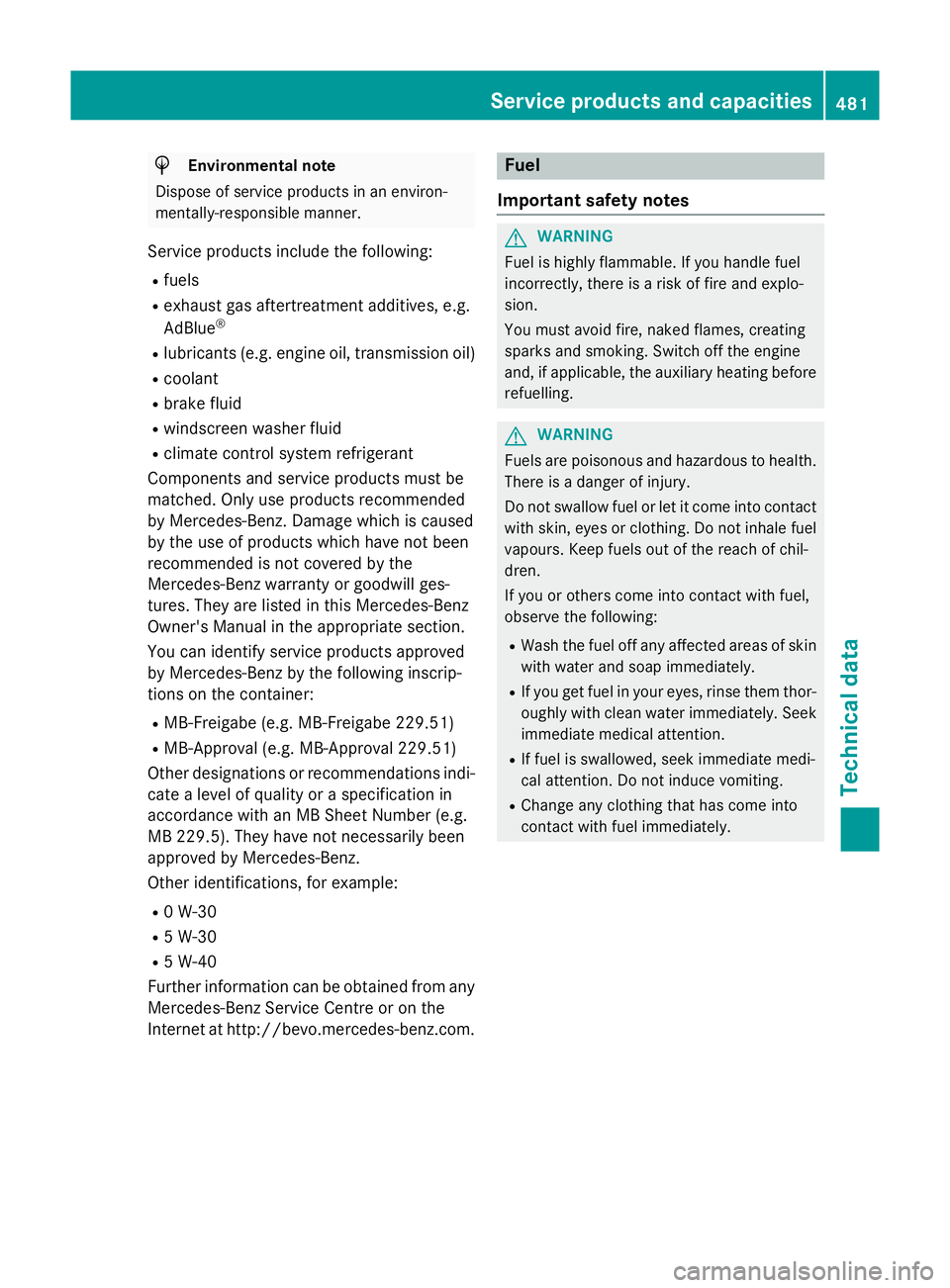
H
Environmental note
Dispose of service products in an environ-
mentally-responsible manner.
Service products include the following:
R fuels
R exhaust gas aftertreatment additives, e.g.
AdBlue ®
R lubricants (e.g. engine oil, transmission oil)
R coolant
R brake fluid
R windscreen washer fluid
R climate control system refrigerant
Components and service products must be
matched. Only use products recommended
by Mercedes-Benz. Damage which is caused
by the use of products which have not been
recommended is not covered by the
Mercedes-Benz warranty or goodwill ges-
tures. They are listed in this Mercedes-Benz
Owner's Manual in the appropriate section.
You can identify service products approved
by Mercedes-Benz by the following inscrip-
tions on the container:
R MB-Freigabe (e.g. MB-Freigabe 229.51)
R MB-Approval (e.g. MB-Approval 229.51)
Other designations or recommendations indi- cate a level of quality or a specification in
accordance with an MB Sheet Number (e.g.
MB 229.5). They have not necessarily been
approved by Mercedes-Benz.
Other identifications, for example:
R 0 W-30
R 5 W-30
R 5 W-40
Further information can be obtained from any
Mercedes-Benz Service Centre or on the
Internet at http://bevo.mercedes-benz.com. Fuel
Important safety notes G
WARNING
Fuel is highly flammable. If you handle fuel
incorrectly, there is a risk of fire and explo-
sion.
You must avoid fire, naked flames, creating
sparks and smoking. Switch off the engine
and, if applicable, the auxiliary heating before refuelling. G
WARNING
Fuels are poisonous and hazardous to health. There is a danger of injury.
Do not swallow fuel or let it come into contact
with skin, eyes or clothing. Do not inhale fuel
vapours. Keep fuels out of the reach of chil-
dren.
If you or others come into contact with fuel,
observe the following:
R Wash the fuel off any affected areas of skin
with water and soap immediately.
R If you get fuel in your eyes, rinse them thor-
oughly with clean water immediately. Seek immediate medical attention.
R If fuel is swallowed, seek immediate medi-
cal attention. Do not induce vomiting.
R Change any clothing that has come into
contact with fuel immediately. Service products and capacities
481Technical data Z
Page 486 of 497
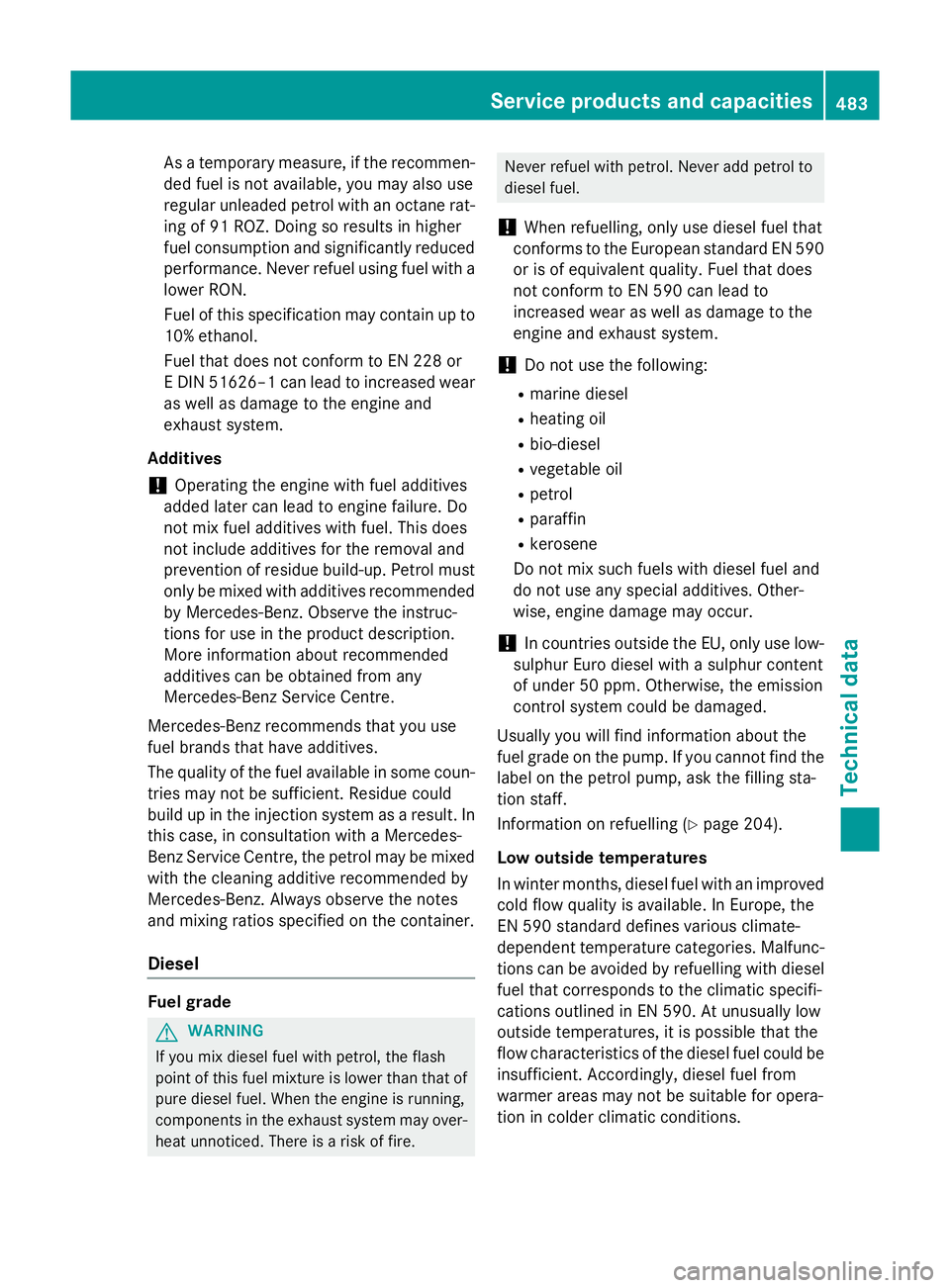
As a temporary measure, if the recommen-
ded fuel is not available, you may also use
regular unleaded petrol with an octane rat-
ing of 91 ROZ. Doing so results in higher
fuel consumption and significantly reduced performance. Never refuel using fuel with a lower RON.
Fuel of this specification may contain up to
10% ethanol.
Fuel that does not conform to EN 228 or
E DIN 51626–1 can lead to increased wear
as well as damage to the engine and
exhaust system.
Additives ! Operating the engine with fuel additives
added later can lead to engine failure. Do
not mix fuel additives with fuel. This does
not include additives for the removal and
prevention of residue build-up. Petrol must only be mixed with additives recommended
by Mercedes-Benz. Observe the instruc-
tions for use in the product description.
More information about recommended
additives can be obtained from any
Mercedes-Benz Service Centre.
Mercedes-Benz recommends that you use
fuel brands that have additives.
The quality of the fuel available in some coun- tries may not be sufficient. Residue could
build up in the injection system as a result. In
this case, in consultation with a Mercedes-
Benz Service Centre, the petrol may be mixed
with the cleaning additive recommended by
Mercedes-Benz. Always observe the notes
and mixing ratios specified on the container.
Diesel Fuel grade
G
WARNING
If you mix diesel fuel with petrol, the flash
point of this fuel mixture is lower than that of pure diesel fuel. When the engine is running,
components in the exhaust system may over-
heat unnoticed. There is a risk of fire. Never refuel with petrol. Never add petrol to
diesel fuel.
! When refuelling, only use diesel fuel that
conforms to the European standard EN 590
or is of equivalent quality. Fuel that does
not conform to EN 590 can lead to
increased wear as well as damage to the
engine and exhaust system.
! Do not use the following:
R marine diesel
R heating oil
R bio-diesel
R vegetable oil
R petrol
R paraffin
R kerosene
Do not mix such fuels with diesel fuel and
do not use any special additives. Other-
wise, engine damage may occur.
! In countries outside the EU, only use low-
sulphur Euro diesel with a sulphur content
of under 50 ppm. Otherwise, the emission
control system could be damaged.
Usually you will find information about the
fuel grade on the pump. If you cannot find the
label on the petrol pump, ask the filling sta-
tion staff.
Information on refuelling (Y page 204).
Low outside temperatures
In winter months, diesel fuel with an improved
cold flow quality is available. In Europe, the
EN 590 standard defines various climate-
dependent temperature categories. Malfunc- tions can be avoided by refuelling with diesel
fuel that corresponds to the climatic specifi-
cations outlined in EN 590. At unusually low
outside temperatures, it is possible that the
flow characteristics of the diesel fuel could be insufficient. Accordingly, diesel fuel from
warmer areas may not be suitable for opera-
tion in colder climatic conditions. Service products and capacities
483Technical data Z
Page 487 of 497

i
Further information on country-specific
fuel properties and fuel types with low-tem-
perature resistance can be obtained from
oil companies, e.g. at filling stations.
Fuel consumption information H
Environmental note
CO 2(carbon dioxide) is the gas which scien-
tists believe to be principally responsible for
global warming (the greenhouse effect). Your
vehicle's CO 2emissions are directly related to
fuel consumption and therefore depend on:
R efficient use of the fuel by the engine
R driving style
R other non-technical factors, such as envi-
ronmental influences, road conditions or
traffic flow
You can minimise your vehicle's CO 2emis-
sions by driving carefully and having it serv-
iced regularly.
The vehicle will use more fuel than usual in the following situations:
R at very low outside temperatures
R in urban traffic
R on short journeys
R in mountainous terrain
R when towing a trailer
i Only for certain countries: you can find
the current consumption and emission val-
ues of your vehicle in the COC documents
(EU CERTIFICATE OF CONFORMITY). These documents are delivered with your vehicle.
The consumption figures were, in each
case, based on the currently applicable ver- sion:
R for vehicles that comply with standards
up to and including the EURO 4 standard,
in accordance with EU Directive
80/1268/EEC
R for vehicles that comply with or exceed
the EURO 5 standard, in accordance with Regulation (EC) No. 715/2007 Deviations from these values may occur
under normal operating conditions. AdBlue
®
Important safety notes AdBlue
®
is a water-soluble fluid for the
exhaust gas aftertreatment of diesel engines. It is:
R non-toxic
R colourless and odourless
R non-flammable
If you open the AdBlue ®
tank, small amounts
of ammonia vapour may be released.
Ammonia vapours have a pungent odour and
are particularly irritating to the skin, to
mucous membranes and to the eyes. You may experience a burning sensation in your eyes,
nose and throat. You may also experience
coughing and watery eyes.
Do not inhale any ammonia vapours that may
be released. Only fill the AdBlue ®
tank in well-
ventilated areas.
Low outside temperatures AdBlue
®
freezes at a temperature of approx-
imately -11 †. The vehicle is delivered from
the factory equipped with an AdBlue ®
pre-
heating system. Winter operation can thus be
guaranteed even at temperatures below
-11 †.
Additives !
Only use AdBlue ®
in accordance with ISO
22241. Do not use additives with AdBlue ®
and do not dilute AdBlue ®
with water. This
may destroy the BlueTEC exhaust gas after-
treatment system. 484
Service products and capacitiesTechnical data
Page 489 of 497
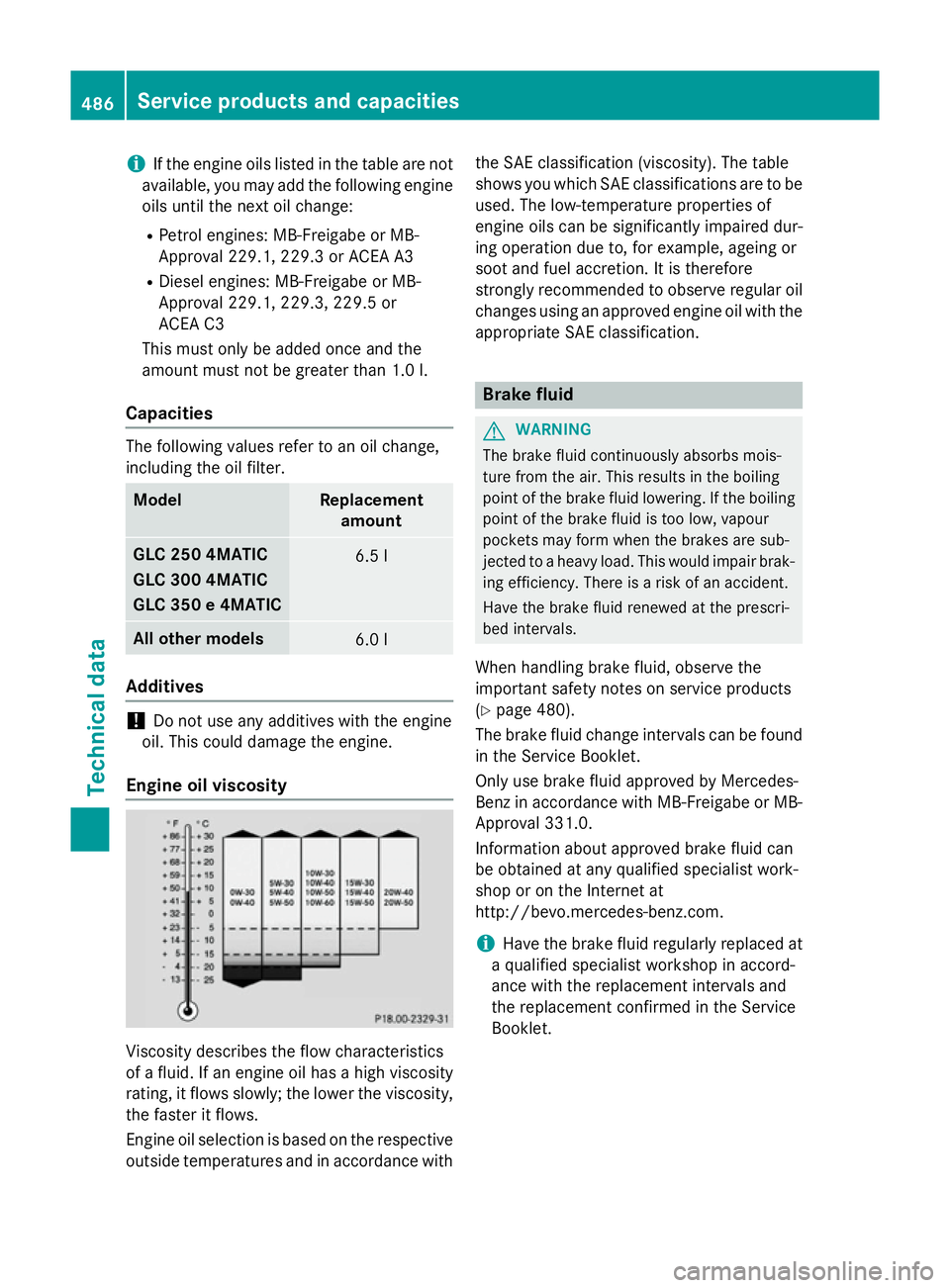
i
If the engine oils listed in the table are not
available, you may add the following engine
oils until the next oil change:
R Petrol engines: MB-Freigabe or MB-
Approval 229.1, 229.3 or ACEA A3
R Diesel engines: MB-Freigabe or MB-
Approval 229.1, 229.3, 229.5 or
ACEA C3
This must only be added once and the
amount must not be greater than 1.0 l.
Ca pacities The following values refer to an oil change,
including the oil filter.
Model Replacement
amount GLC 250 4MATIC
GLC 300 4MATIC
GLC 350 e 4MATIC 6.5 l
All other models
6.0 l
Additives
!
Do not use any additives with the engine
oil. This could damage the engine.
Engine oil viscosity Viscosity describes the flow characteristics
of a fluid. If an engine oil has a high viscosity
rating, it flows slowly; the lower the viscosity,
the faster it flows.
Engine oil selection is based on the respective outside temperatures and in accordance with the SAE classification (viscosity). The table
shows you which SAE classifications are to be
used. The low-temperature properties of
engine oils can be significantly impaired dur-
ing operation due to, for example, ageing or
soot and fuel accretion. It is therefore
strongly recommended to observe regular oil changes using an approved engine oil with the
appropriate SAE classification. Brake fluid
G
WARNING
The brake fluid continuously absorbs mois-
ture from the air. This results in the boiling
point of the brake fluid lowering. If the boiling
point of the brake fluid is too low, vapour
pockets may form when the brakes are sub-
jected to a heavy load. This would impair brak- ing efficiency. There is a risk of an accident.
Have the brake fluid renewed at the prescri-
bed intervals.
When handling brake fluid, observe the
important safety notes on service products
(Y page 480).
The brake fluid change intervals can be found in the Service Booklet.
Only use brake fluid approved by Mercedes-
Benz in accordance with MB-Freigabe or MB-Approval 331.0.
Information about approved brake fluid can
be obtained at any qualified specialist work-
shop or on the Internet at
http://bevo.mercedes-benz.com.
i Have the brake fluid regularly replaced at
a qualified specialist workshop in accord-
ance with the replacement intervals and
the replacement confirmed in the Service
Booklet. 486
Service products and capacitiesTechnical data